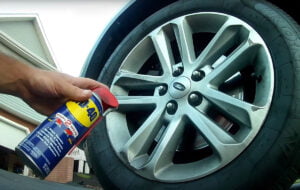Modern cars come with all types of sensors and systems that help the car to work correctly at all times. Keeping in view the fact that most cars now move at the speed of 70 mph regularly, these systems are critical from a life-saving aspect. So, you need to learn what they are and what to do if you face these warning lights on your dashboard.
What Is A Service Tire Monitoring System?
A tire pressure monitoring system (TPMS) is built to collect data about the air pressure within your tires. If the system considers that one of your tires contains low tire pressure, it will show a warning light on your dashboard. However, these systems can result in problems after a while because they are prone to mishaps.
Tire monitoring systems are generally located within the tire, which means they might stop working if you go over a bad pothole or the sensors have become useless. Apart from that, the “service tire monitoring system” warning light means that the system needs to replace the faulty system parts so that the system can detect the data as it is intended to do so.
What Can Cause My Service Tire Monitoring System Warning Light To Turn On?
- Battery issues
- Faulty sensors
- Deflated tires
- Aggressive potholes
Battery Issues
The battery is the component that powers all in-car electronics, which works simultaneously with the alternator to provide non-stop power to all car accessories, but not the TPMS. The reason behind this is that the TPMS is available within the rim, and there is no effective way to connect the battery to the system.
That is why a TPMS sensor usually has a small battery that works independently instead of using the car’s main battery. As all batteries can stop working due to discharge, the one situated within the TPMS sensor will stop working eventually. The average lifespan of a TPMS sensor battery can be around 5 to 6 years.
Faulty Sensors
As I mentioned above, these TPMS tire sensors are famous for stopping working from time to time due to their constant working under stress, especially if you often drive your vehicle on unpaved roads. Because their location is directly on the inside of the rim, they are prone to increased vibrations.
This is one of the most common causes why TPMS lights are turned on, and repairs can be done by simply replacing the sensors. According to experts, TPMS sensors can work anywhere between 5 and 10 years, depending on how much driving you do during that period.
Deflated Tires
It is another common reason why the TPMS light comes on when your tires are not inflated enough (deflated). Most tires do not maintain proper tire pressure with time, which can help the systems spot it. These systems can detect it, and you can fix it by simply airing up the tires and rebooting your car. If the warning light remains there, the tires may not be the reason.
It can also be an indication that you have a slow puncture. You should always check your tires for damage whenever this light turns on.
Aggressive Potholes
Since these sensors remain close to the ground, they are shaken regularly while you drive. That is the reason why you misread the data they are gathering: because you went over an aggressive pothole. Such a strong disturbance can trouble the tire sensor and cause it to think that your tires are not inflated properly.
This problem can be solved by simply restarting the car. However, if the problem persists, this can indicate that the tire sensor has been damaged or that your tires are deflating because of the blunt force impact.
How Much Does It Cost To Replace A TPMS Sensor?
To replace all four TPMS sensors simultaneously, you will need to pay between $$50-$100 bills, including labor. It also depends on whether they can change the TPMS sensor without taking the entire tire off. It hardly happens with most cars, but if you own a car that can replace the TPMS sensors without taking the wheel off, you will be charged less.
The make and model year of your car is also essential for replacing TPMS sensors, as not all cars are designed with the same technology.
Can I Drive When My Tire Monitor System Light is On?
Yes, you can drive with your TPMS light on if you carefully check your tires. As these systems often stop working because of air-pressure unrelated things, you can drive the car even though the light is on. However, if you are willing to do this, you should constantly monitor tire pressure.
Alternatively, if you have deflated tires, you should abstain from driving the car if it is not imperative. At times, a tire might face a slow puncture that causes the air to release slowly, but that does not indicate that the tire is entirely safe.
What Are The Advantages Of Properly Inflated Tires?
All modern cars are made with a specific air pressure level as it is necessary for safety and performance. If you have underinflated tires, you will experience bad fuel economy and uneven levels of traction, and there are high chances that you will face tire blowouts.
Additionally, you will be restricted from significant speeds, which will also affect your load rating and drop it severely. If you overinflate your tires, you are put at risk of explosion while also making the ride more uncomfortable.
Final Words
The service tire monitor system means that your tire pressure monitoring system is no longer working as it is meant to. It can happen for different reasons, such as faulty sensors, a tire filled to an incorrect pressure, a dead sensor battery, or when you want over a pothole aggressively.
The TPMS sensor is known to fail, indicating that changing it is like regular maintenance. The cost of replacing TPMS sensors can depend on the make and model year of the car and if you have to remove the tires to change them.



